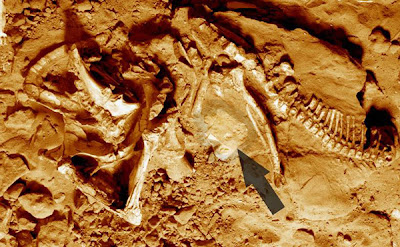We know a tremendous amount about dinosaurs from studying their fossilized remains, but the amount that we don’t know or haven’t seen in the fossil record far surpasses our knowledge. I’m a sure sucker for a good dinosaur fossil story, and pitched several while interning at Geekosystem over the summer. I’m still working through my list of links that didn’t make the cut this summer, and wanted to share this dinosaur discovery (that I read about in this New Scientist article).
 |
| Image credit: Grzegorz Niedzwiedzki |
To say that something stopped dead in its tracks is a common phrase, but it is really an uncommon occurrence. That is what makes the discovery by Polish paleontologists of a Protoceratops fossilized alongside impressions of its final footprints so impressive. This dinosaur was literally stopped dead in its tracks. The fossils were found in Mongolia, and belong to a dinosaur that lived approximately 80 million years ago. Due to the fact that finding fossilized remains of land animals and their tracks is so rare, the discovery is particularly exciting.
It is rare to find a fossilized land vertebrate alongside its footprints, because generally the conditions needed to preserve tracks and bone are different. It is easier to observe invertebrate marine creatures fossilized with their tracks because a single layer of sediment is more likely to be able to preserve both. Adding to the difficulty is the challenge of matching tracks with a specific creature. The pads or soft tissue that covers a foot isn’t going to be preserved on the skeleton, which will make it harder to match tracks with a species.
Identifying footprints by the creature that created them is so complex, it has its own scientific field of study. As a subspeciality of geology, ichnologists study footprints and can typically narrow a footprint down to a specific type of animal, and sometimes the species. The Protoceratops fossil was discovered by a joint Polish-Mongolian team from the Gobi Desert in 1965. Yes, 1965. It took 45 years for the fossil slab to be analyzed, but when it finally was, Grzegorz Niedzwiedzki of the University of Warsaw was shocked at what he found.
Niedzwiedzki and colleagues discovered an impression near the dinosaur’s pelvis. The shape and size correspond with what would be expected from the Protoceratops’ four-toed foot. This is the first time that scientists have observed fossilized Protoceratops tracks from this region and time period, in addition to being the rare tracks of a land animal preserved next to that animal. If you are interested in learning more about this find, the researchers published their study in the journal Cretaceous Research.